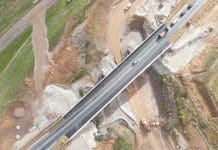National Highways, the government-owned company responsible for operating, maintaining and improving motorways and major roads, has embraced geospatial technology that, for the first time gives staff a real-time view of the network
National Highways recently received an Esri Special Achievement in GIS Award for its innovative use of geospatial technology, which enables a quicker response to incidents on the road network.
These global awards recognise geospatial leadership and organisations setting new precedents for the GIS (Geographic Information System) community.
National Highways is using enterprise GIS from Esri UK to support its Digital Roads strategy by consolidating all geospatial data and applications into one spatial portal, adding new capabilities and making GIS more accessible at lower cost.
Real-time view
Projects have included creating a single digital model of the Strategic Road Network (SRN) to provide staff with the same real-time view for the first time.
Spatial data in the SRN model includes information on over 4,000 miles of highway, bridges, tunnels, and other assets, including road signs and cameras. Companies that rely on the SRN contribute over £400bn in Gross Value Added to the economy.
Control rooms across the country are now using a single view of the network dashboard, which has incident alerts, details of roadworks, weather updates and the location of traffic officers available on an interactive map.
Optimising traffic flows
Benefits to date include being able to predict problem locations and deploy traffic officers more quickly, better coordination of roadworks to reduce disruption and optimising traffic flows to reduce congestion and emissions.
It has also removed the need to maintain multiple road models within multiple systems and, through these efficiencies, National Highways has decreased its total cost of GIS ownership by more than 10% compared with two years ago.
National Highways made the move to an Esri enterprise GIS over a year ago, following recognition that geospatial data was its most critical type of data – the result of an in-depth asset evaluation, which valued its data overall at £60bn.
The GIS consolidates all location data into one central system and provides a wide range of applications, data models and other GIS services, enabling 5,660 staff and the supply chain to make better use of spatial data.
Data-driven culture
Davin Crowley-Sweet, chief data officer at National Highways, said: “This award is a significant achievement for our team. Our spatial data is the crown jewel of our data landscape – the primary key of primary keys.
Having a single view of it to support the whole organisation helps foster a data-driven culture, increasing business benefits and is critical for delivering our Digital Roads vision and beyond.
“We are always looking for new ways to make people’s journeys smoother and safer on our roads and we are now able to react more swiftly to incidents to get traffic moving again as quickly as possible. Meanwhile, our vision for the digital roads of the future will incorporate new capabilities, such as digital twins, predictive planning, single view of assets and connected autonomous vehicles. Each of these initiatives will require a common, trusted representation of the network to be successful.”
Driving more value from spatial data
National Highways is at the forefront of demonstrating what a true enterprise GIS can achieve. Technology is helping to maximise the value gained from geospatial data, which is now used more extensively across the organisation.
Taking an enterprise approach gives National Highways a solid, scalable foundation to help meet its Digital Roads objectives and tackle some of the most pressing challenges facing our roads today and in years to come.
National Highways is the government company charged with operating, maintaining and improving England’s motorways and major A roads. Its ambition is to ensure major roads are more dependable, durable and – most importantly – safe.
The organisation has set out its Digital Road 2025 vision detailing how the growth of digital technology and the move to electric, connected and autonomous vehicles will fundamentally change how roads are designed, built, operated and used by drivers. More information can be found on the Digital Roads webpage.
Chris Barber
Head of transport and infrastructure
Esri UK
Tel: +44 (0)1296 745500




![[VIDEO] HS2 completes 4,600-tonne viaduct slide across M6 The HS2 team completed a 17-hour long operation sliding the viaduct structure across the M6 without closing the motorway](https://www.pbctoday.co.uk/news/wp-content/uploads/2025/12/M6-South-viaduct-slide-taking-place-across-a-live-motorway-December-2025-218x150.jpg)





![[VIDEO] Heathrow’s third runway plan wins out over Arora London, United Kingdom – May 31, 2023: A commercial airliner taking off at London's Heathrow Airport, representing plans for a third runway](https://www.pbctoday.co.uk/news/wp-content/uploads/2025/11/iStock-2143084103-218x150.jpg)



